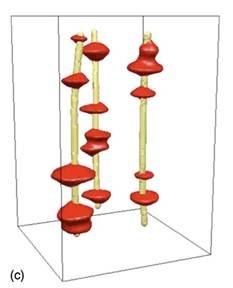
James A. Warren1, Tamás Pusztai2, László Környei3, László Gránásy2,4
1Metallurgy Division, National Institute of Standards and Technology, Gaithersburg, Maryland 20899, USA
2Institute for Solid State Physics and Optics, Wigner Research Centre for Physics, P.O. Box 49, Budapest H-1525, Hungary
3Department of Mathematics and Computational Sciences, Széchenyi István University, Győr 9026, Hungary
4BCAST, Brunel University, Uxbridge, Middlesex, UB8 3PH, United Kingdom
We extend the phase field model of heterogeneous crystal nucleation developed recently [L. Gránásy et al., Phys. Rev. Lett. 98, 035703 (2007)] to binary alloys. Three approaches are considered to incorporate foreign walls of tunable wetting properties into phase field simulations: a continuum realization of the classical spherical cap model (called model A herein), a nonclassical approach (model B) that leads to ordering of the liquid at the wall and to the appearance of a surface spinodal, and a nonclassical model (model C) that allows for the appearance of local states at the wall that are accessible in the bulk phases only via thermal fluctuations. We illustrate the potential of the presented phase field methods for describing complex polycrystalline solidification morphologies including the shish-kebab structure, columnar to equiaxed transition, and front-particle interaction in binary alloys.


